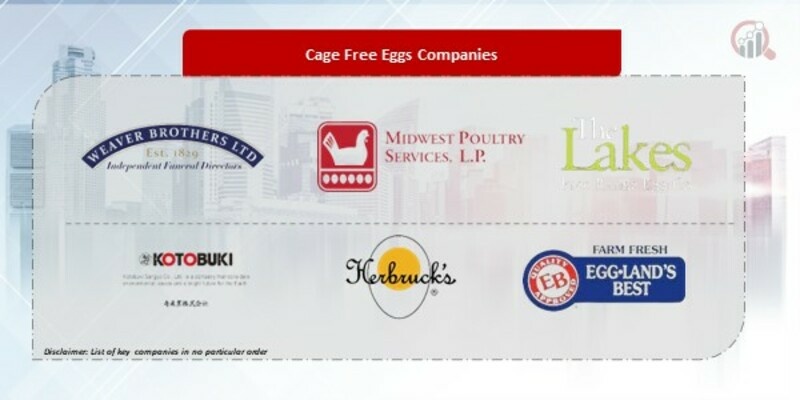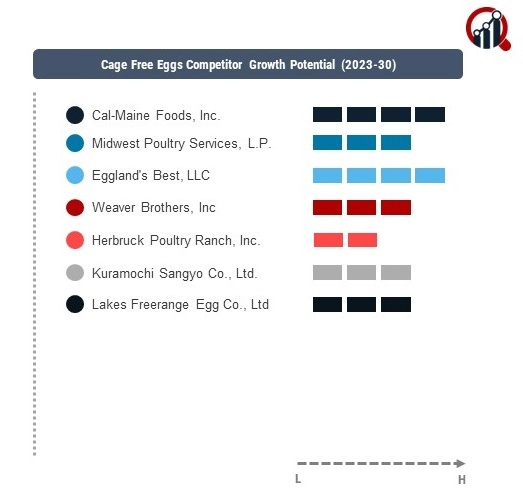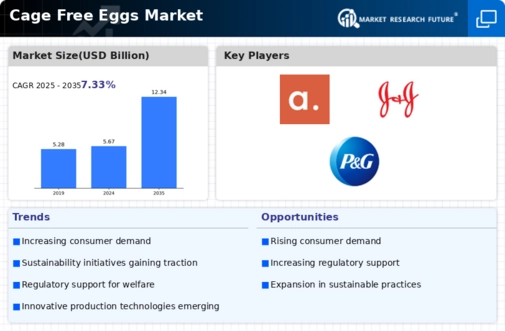Top Industry Leaders in the Cage Free Eggs Market
 The Cage-Free Eggs market is a significant segment within the broader poultry and egg industry, characterized by a competitive landscape influenced by factors such as increasing consumer awareness of animal welfare, a shift towards sustainable and ethical consumption, and the evolving regulatory landscape surrounding egg production practices. As of 2023, key players in this market strategically position themselves, implementing various strategies to maintain or enhance their market share.
The Cage-Free Eggs market is a significant segment within the broader poultry and egg industry, characterized by a competitive landscape influenced by factors such as increasing consumer awareness of animal welfare, a shift towards sustainable and ethical consumption, and the evolving regulatory landscape surrounding egg production practices. As of 2023, key players in this market strategically position themselves, implementing various strategies to maintain or enhance their market share.
Key Players:
Leading the Cage-Free Eggs market are key players such as
Cal-Maine Foods Inc. (U.S.)
Kuramochi Sangyo Co. Ltd. (Japan)
Midwest Poultry Services L.P.(U.S.)
Weaver Brothers Inc. (U.S.)
Herbruck Poultry Ranch Inc. (U.S.)
Lakes Freerange Egg Co. Ltd. (U.K.)
Eggland's Best LLC. (U.S.)
These companies are recognized as industry leaders, leveraging their extensive experience, production capacities, and comprehensive supply chain networks to meet the growing demand for cage-free eggs.
Strategies Adopted:
Key players in the Cage-Free Eggs market deploy various strategies to remain competitive. Strategic partnerships with retailers, foodservice providers, and food manufacturers contribute to expanding the market reach and distribution of cage-free eggs. These companies often invest in upgrading existing facilities or building new farms with a focus on cage-free production systems, meeting consumer expectations for improved animal welfare. Marketing efforts emphasize the humane treatment of hens, egg quality, and transparency in labeling to build trust with consumers. Additionally, key players actively engage in industry initiatives and certifications that promote responsible egg production practices.
Market Share Analysis:
Market share analysis in the Cage-Free Eggs market is influenced by several factors, including brand reputation, product quality, pricing strategies, and distribution efficiency. Companies with strong brand equity and a history of producing high-quality cage-free eggs tend to secure a larger market share. Pricing strategies that align with consumer perceptions of value for ethically produced eggs play a crucial role, given the competition with conventional eggs and other specialty eggs. Efficient distribution networks covering both retail and foodservice channels are vital for maintaining a competitive edge in delivering cage-free eggs to consumers.
New and Emerging Companies:
While key players dominate the Cage-Free Eggs market, new and emerging companies are entering the sector, often focusing on niche markets or implementing innovative production methods. These entrants may emphasize regional or local production, unique egg varieties, or employ technologies that enhance the efficiency of cage-free egg farming, contributing to the overall diversification and innovation in the Cage-Free Eggs market. Although their market share may be relatively modest compared to industry leaders, these companies play a role in driving sustainable practices and addressing the evolving demands of ethically conscious consumers.
Industry Trends:
The Cage-Free Eggs market has witnessed noteworthy industry news and investment trends in 2023. Key players are investing in technology adoption, with a focus on implementing advanced monitoring systems and automation to enhance the efficiency of cage-free egg production. Investments in sustainable practices, such as renewable energy sources and waste reduction initiatives, respond to the growing consumer interest in environmentally responsible food production. Additionally, partnerships with animal welfare organizations and certifications underline the commitment of key players to meeting and exceeding industry standards for cage-free egg production.
Competitive Scenario:
The overall competitive scenario in the Cage-Free Eggs market is marked by intense rivalry among key players striving to capture a larger share of the market. The industry's competitiveness is evident in the emphasis on innovation, sustainability, and ethical production to address evolving consumer preferences and regulatory requirements. The global reach of these companies enables them to adapt to regional variations in demand, capitalize on emerging markets, and navigate complex regulatory landscapes, contributing to the overall dynamism of the industry.
Recent Development in 2023:
Enriched Eggs: To appeal to consumers who are health-conscious, some firms have introduced cage-free eggs with additional vitamins, minerals, or omega-3 fatty acids.
Plant-Based Substitutes: Although cage-free eggs continued to dominate the industry in terms of volume, the emergence of plant-based egg alternatives posed a challenge to the established market.


